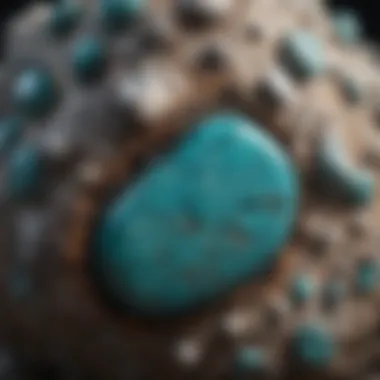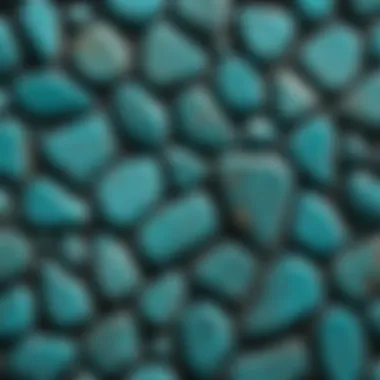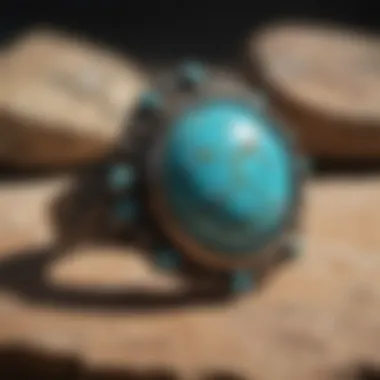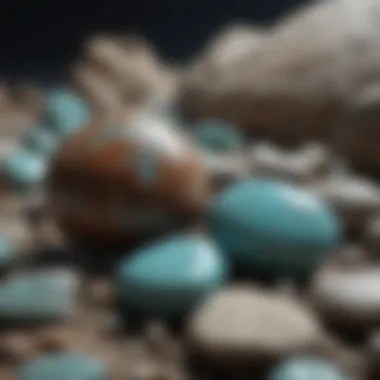Exploring Rough Turquoise Stones: Characteristics & Uses


Intro
Rough turquoise stones captivate collectors and connoisseurs, not only for their vibrant colors but also for their intricate history and cultural significance. This article seeks to explore various dimensions of these stones, from their geological formation to their current applications. Understanding turquoise involves delving into its physical attributes, historical context, and the factors that impact its valuation in today’s market. Given the rising interest in natural stones and the craftsmanship involved in jewelry making, this exploration is timely and relevant for both collectors and enthusiasts alike.
Foreword to Rough Turquoise Stones
Rough turquoise stones hold a significant place in the world of geology, culture, and craftsmanship. Their unique attributes make them a subject of great interest for collectors and enthusiasts alike. This section addresses the essentials of turquoise, offering an overview of its definition and exploring the characteristics that distinguish rough stones.
Definition of Turquoise
Turquoise is a blue to green mineral that has been valued for its beauty and rarity. Scientifically, it is classified as a hydrous phosphate of copper and aluminum that forms in deposits associated with copper mines. The stone has captivated many civilizations over thousands of years, often symbolizing protection, tranquility, and healing.
The color of turquoise is primarily a result of the copper content; its variations produce a spectrum from sky blue to greenish hues. The presence of iron can add a yellowish tone. Turquoise is not only desired for its physical properties but also for its historical significance across cultures. Different societies attributed various meanings to the stone, and it often appeared in jewelry, artifacts, and ceremonial items.
Overview of Rough Stones
Rough stones refer to gemstones that have not undergone any form of polishing or cutting. In their natural state, these stones retain the raw beauty of their geological formation. Rough turquoise is particularly sought after because it offers enthusiasts a chance to examine the mineral in its authentic form, revealing its true colors and textures.
The appreciation of rough turquoise contrasts with polished varieties, which can sometimes mask the unique characteristics present in natural stones. Rough stones also provide insights into the stone's origin, as variations in texture and coloration reflect the geological conditions under which they formed. Collectors often seek these stones not only for their aesthetic appeal but also for their potential to be crafted into distinctive jewelry pieces or kept as a fascinating addition to any collection.
"Rough turquoise stones serve as a physical connection to the Earth’s history, encapsulating the processes that shape them over millennia."
A deeper exploration of rough turquoise's geological formation, physical properties, and cultural significance reveals the complex narratives surrounding these stones, making them an enriching subject of study for collectors and connoisseurs.
Geological Formation of Turquoise
The geological formation of turquoise is a critical aspect of this unique stone's allure and value. Understanding how turquoise forms enhances our appreciation of its characteristics and significance. The process of formation is complex, involving various factors related to mineral composition and environmental conditions. Each of these elements contributes to the stone's aesthetic appeal, durability, and rarity. This knowledge not only informs collectors about the origins of their specimens but also impacts the market dynamics in the turquoise industry.
Mineralogical Composition
Turquoise is primarily composed of hydrous copper and aluminum phosphate. Its chemical formula is CuAl6(PO4)4(OH)8·4O. This composition defines its color and structure. The presence of copper gives turquoise its striking blue color, while variations in iron can lead to greenish hues. These color variations result from the trace elements within the mineral structure, providing a wide range of visual appeal.
The mineral also contains small amounts of zinc, manganese, and other trace minerals. The presence of these additional elements influences the texture and overall appearance of the stone. As a collector, recognizing these subtle differences in mineral composition can aid in identifying genuine turquoise.
Environmental Conditions for Formation
The formation of turquoise occurs under specific environmental conditions. This stone typically forms in arid climates where chemical weathering processes are prominent. It often develops in the oxidation zones of copper deposits. As water percolates through these deposits, it dissolves copper and other minerals which then react with phosphate sources present in the surrounding rocks.
This process is greatly influenced by the pH levels of the water and the presence of organic matter. The ideal conditions include:
- Low to moderate temperatures: These temperatures can prevent excessive evaporation, allowing turquoise to form more effectively.
- Alkaline soils: Favorable conditions for the chemical reactions needed in the formation of turquoise.
- Presence of specific minerals: Such as limestone, which serves as a host rock for turquoise deposits.
The unique geological conditions required for the formation of turquoise make it a finite resource. This scarcity adds to its allure among collectors and jewelers alike. Understanding these environmental factors not only enhances appreciation for the stone but also sheds light on its ecological significance in its natural habitat.
The rarity and distinct hues of turquoise stem from a delicate interplay of mineralogical and environmental factors.
Physical Properties of Rough Turquoise
The physical properties of rough turquoise are essential for understanding its uniqueness and desirability. These properties not only influence the aesthetic appeal of the stone but also impact its usability in various applications. Recognizing these characteristics can help collectors evaluate the quality and authenticity of the turquoise they encounter.


Color Variations
Turquoise displays a diverse palette, ranging from vibrant sky blue to deep green. The variations in color are primarily due to the presence of copper and iron in its mineral composition. Each hue carries its own significance and charm, which collectors often seek. The blue shades, often associated with high copper content, are particularly prized, while more greenish tones indicate the influence of iron.
The intensity of the color also matters. Bright, saturated stones tend to command a higher market value compared to those with a milky or dull appearance. Some rough turquoise stones feature intricate patterns or veining, adding to their appeal. This color variety, combined with individual preferences, makes sourcing turquoise an engaging endeavor for both collectors and jewelers alike.
Hardness and Durability
Turquoise is classified as a relatively soft gemstone, registering between 5 and 6 on the Mohs scale of mineral hardness. This softness means it is more susceptible to scratching and damage compared to harder gemstones such as diamond or sapphire. Consequently, proper care and usage are critical when working with rough turquoise.
Despite its softness, turquoise possesses a level of durability that allows it to be crafted into jewelry and other items. When treated properly, it can withstand daily wear. However, collectors should always be aware of the specific care requirements. For example, avoiding exposure to harsh chemicals or extreme temperatures can prolong the lifespan of turquoise items significantly.
Proper understanding and care of turquoise can enhance its durability and visual appeal over time.
Texture and Luster
The texture of rough turquoise can vary significantly, contributing to its uniqueness. Some stones exhibit a smooth, even surface, while others may present a more porous or uneven texture. This variation in texture can affect how light interacts with the stone, influencing its overall luster.
In terms of luster, turquoise can exhibit a waxy, dull, or even semi-vitreous finish. Stones that display a higher sheen are often viewed as more desirable by collectors. The luster not only impacts aesthetic value but also plays a role in how the stone fits into various applications, such as jewelry making.
Understanding these physical properties enables both collectors and artisans to make informed decisions about the selection, use, and care of rough turquoise. This knowledge is essential, as it defines the vibrancy and longevity of the turquoise they cherish.
Cultural Significance of Turquoise
Turquoise carries a rich cultural background that extends across various civilizations and moments in history. Its value transcends mere aesthetics. The significance lies in its symbolic meanings, historical use, and contemporary relevance. Understanding this context enriches our appreciation of turquoise, especially for those who collect minerals and stones, as it reflects the stone's multifaceted role in human society.
Historical Use by Indigenous Peoples
Historically, turquoise has held a place of importance among many Indigenous cultures, especially in the Americas. Native American tribes, such as the Navajo and Hopi, integrated turquoise into their rituals and daily lives. They believed it offered protection, healing, and good fortune. Its vibrant blue and green hues were seen as a reflection of the sky and water, elements vital for survival.
Artifacts crafted from turquoise, such as jewelry, amulets, and ceremonial items, illustrate its value. For these communities, the stone was not only decorative but also spiritual. Turquoise was often used in significant rituals and was considered an embodiment of life itself. In many cases, it was thought to enhance intuition and bring the wearer closer to the spirit world.
Modern Symbolism and Beliefs
In contemporary society, turquoise continues to be a powerful symbol. Many people associate it with tranquility, healing, and protection. This association has led to its use in various wellness practices. Some individuals wear turquoise to foster calmness and reduce stress. Its vibrant color resonates with ideas of clarity and emotional balance.
Moreover, the fusion of traditional beliefs into modern lifestyles has kept turquoise relevant today. In various cultures, the stone symbolizes friendship, loyalty, and communication. These qualities are often valued in personal relationships and community bonds. It's not uncommon to see turquoise incorporated into contemporary jewelry designs, further emphasizing its ongoing significance.
"Turquoise is not just a rock; it represents deep cultural ties and personal connections that enrich the lives of many."
Value Assessment of Rough Turquoise Stones
Assessing the value of rough turquoise stones is crucial for both collectors and traders. It enables individuals to understand what makes a piece unique and helps them make informed decisions regarding purchases and sales. In the world of gemstones, turquoise stands out for its beauty and historical significance. However, many factors contribute to the overall market value of rough turquoise, which may not be immediately apparent to those new to the field.
The assessment provides insights into the specific elements affecting market demand. Certain characteristics of turquoise can increase its desirability, leading to variations in price.
Factors Influencing Market Value
When determining the market value of rough turquoise stones, several key factors come into play:


- Color: The hue of the stone is among the most critical aspects. Turquoise ranges from light blue to greenish-blue shades. Rich, vibrant colors typically fetch higher prices.
- Origin: The geographical source influences value. Stones from notable locations, such as the Sleeping Beauty mine in Arizona or the Persian mines of Iran, are often more sought after.
- Clarity and Matrix: Turquoise can exhibit matrix patterns—veins of different minerals within the stone. A stone with a minimal matrix may be more valuable because it appears purer. On the contrary, some collectors prefer stones with distinctive matrix patterns for their uniqueness.
Additionally, the overall grade of the stone, including its hardness and the absence of significant cracks or damages, influences its assessing value as well.
Assessment Techniques
To assess the value of rough turquoise, various techniques are employed by experts and collectors alike. Here are some of the prominent methods:
- Visual Inspection: Initial evaluations are often made through visual inspection. Experts check for color saturation, matrix patterns, and potential flaws.
- Testing Hardness: Turquoise typically has a hardness of 5 to 6 on the Mohs scale. Using tools to test its hardness helps verify authenticity.
- Gemological Equipment: Some collectors may use specialized equipment like refractometers or polariscope to examine the stone scientifically. These devices help identify the mineral composition and treatment effects.
- Market Analysis: Monitoring current market trends and auction results can provide context for what similar stones have sold for recently.
Understanding how to assess rough turquoise not only aids in making astute purchases but also enriches the entire collecting experience.
Collectively, these methods contribute to a comprehensive understanding of a turquoise stone's value, ensuring that collectors and enthusiasts can appreciate its worth both in terms of monetary value and sentimental significance.
Applications of Rough Turquoise
Rough turquoise stones have a wide range of applications, reflecting both their aesthetic beauty and intrinsic value. This section elaborates on key areas where these stones are utilized, particularly in jewelry making and decorative arts. Understanding the nuances of these applications not only enhances appreciation for the stone but also informs collectors about the potential uses and values.
Jewelry Making
When it comes to jewelry making, rough turquoise stands out as a highly sought-after material. Its unique colors and variations allow artists to create both traditional and innovative designs. Turquoise can be shaped into cabochons, beads, or left in its natural state, each form having its own appeal.
Importance in Jewelry Craft
The aesthetic appeal of turquoise lies in its captivating hues, which can range from sky blue to greenish tones. Artisans often highlight these colors in settings that allow the natural texture of the stone to enhance its visual interest. Moreover, rough turquoise is prized for its symbolism of protection and healing, making it a favored choice among jewelers who aim to resonate with spiritual themes.
Considerations for Jewelers
When using rough turquoise in jewelry, several factors come into play:
- Quality of the Stone: Collectors should look for minimal surface blemishes and even color distribution.
- Durability: Turquoise is relatively soft, typically rating between 5 and 6 on the Mohs hardness scale. This necessitates careful handling and setting to prevent scratches or chips.
- Authenticity: Real turquoise often contains matrix patterns, which are the natural veins within the stone. Being able to recognize these can help in identifying genuine stones versus imitations.
- Market Trends: Understanding current fashion trends can inform jewelers on how to best utilize turquoise in their collections, whether in bold statement pieces or delicate jewelry.
Decorative Arts
Rough turquoise is not confined to jewelry. Its applications extend robustly into decorative arts, where it serves both as an aesthetic component and as a valuable material for crafting. Decorative objects can range from inlaid furniture to unique art pieces and even home decor items.
Value in Decorative Arts
In the decorative arts domain, the characteristics of rough turquoise elevate the artistic value of various creations. Artists and designers often embed turquoise into pottery, sculptures, and wall hangings. Its natural beauty adds depth and color to art, creating visually compelling pieces that attract attention.
Considerations for Artisans
Artisans working with rough turquoise face several considerations:
- Integration Techniques: Whether using turquoise as inlay or as a standalone piece, the technique impacts the overall aesthetic. Proper integration requires skill to balance the stone's color with the rest of the piece.
- Sourcing: Finding high-quality rough turquoise can be a challenge, but it is crucial for high-impact works. Establishing relationships with reliable suppliers can ensure access to the best materials.
- Audience Appeal: Understanding the target audience's preferences for color, size, and form can significantly affect marketability and value.
Rough turquoise can be a captivating choice not only in jewelry but also as a unique element in decorative arts, making it a critical area for both art and expression.
Collecting Rough Turquoise Stones


Collecting rough turquoise stones can be a fulfilling endeavor for enthusiasts and collectors alike. These stones not only represent natural beauty but also hold historical and cultural significance. As turquoise has a rich heritage and spiritual importance across various cultures, collectors often find that acquiring rough pieces deepens their appreciation of the stone. Furthermore, collecting provides insights into geology, artistry, and the market dynamics surrounding precious stones.
Where to Source Rough Turquoise
When looking for rough turquoise, sourcing properly is essential. There are several avenues from which collectors can obtain their stones.
- Local Gem Shows: These events are often held in various regions, allowing collectors to interact directly with vendors who specialize in turquoise. Here, you can find various grades and pieces suitable for your collection.
- Mining Locations: Visiting active turquoise mines can provide a firsthand look at the extraction processes. Notable mines, like those in Arizona and New Mexico, may offer the chance to buy directly from miners, ensuring authenticity.
- Rock and Mineral Shops: Many specialized shops sell rough stones, including turquoise. These stores typically have knowledgeable staff who can offer insights on sourcing and stone quality.
- Online Marketplaces: Websites such as eBay and Etsy list numerous rough turquoise pieces. However, buyers should proceed with caution and verify seller reputation before purchasing.
Having multiple sources can significantly enrich a collection, providing both variety and depth.
Identifying Authenticity
Identifying the authenticity of rough turquoise is critical to ensure that collectors are investing in genuine stones. There are specific traits and tests to consider:
- Color and Patterns: Natural turquoise often displays unique color variations, including shades of blue and green. Contrarily, dyed stones tend to have a more uniform appearance.
- Veining: Many natural turquoises exhibit distinctive veining patterns. The presence of these veining helps in recognizing authentic products.
- Hardness Test: Turquoise typically has a rating of 5 to 6 on the Mohs scale. Conducting a scratch test on an inconspicuous area can help determine hardness.
- Heat and Chemical Tests: Be wary of changes during these tests. Genuine turquoise will resist alterations compared to synthetic alternatives.
- Certification: Reliable sellers may offer certification with their stones, confirming their authenticity and origin.
"When collecting rough turquoise, understanding its authenticity not only preserves the value of your investment but also enhances the joy of your collecting experience."
Care and Preservation of Turquoise
The care and preservation of turquoise are paramount for ensuring its longevity and beauty. This section will delve into effective cleaning methods and prudent storage considerations for rough turquoise stones. Recognizing these elements preserves not only the physical attributes of these gems but also their cultural and historical significance.
Cleaning Methods
Cleaning turquoise requires a gentle approach due to its relatively soft nature. Its hardness ranges from 5 to 6 on the Mohs scale, making it susceptible to scratches and damage. Here are some recommended methods for cleaning your turquoise:
- Use Soft Cloths: Always use a clean, soft, lint-free cloth to wipe off any dust or residue. Avoid coarse materials which can scratch the surface.
- Mild Soap and Water: If stones are heavily soiled, use a mix of lukewarm water and mild soap. Dip the soft cloth in this solution and gently clean the turquoise. Rinse the gemstone with clean water to remove any soap residue. Ensure to dry the stone immediately to prevent moisture from settling in.
- Avoid Harsh Chemicals: Products containing bleach or ammonia should never come in contact with turquoise. These substances can damage the stone and impact its color.
- No Ultrasonic Cleaners: Ultrasonic cleaners may cause fractures or alter the appearance. They should definitely be avoided.
"The key to maintaining the allure of turquoise lies in simplicity—gentleness is the first rule of care."
Storage Considerations
Proper storage of turquoise stones will help protect them from physical and environmental damage. Here’s how to store your turquoise effectively:
- Individual Pouches: Each turquoise piece should be stored in its own soft pouch. This will prevent any scratching that may occur during storage.
- Avoid Direct Sunlight: Direct sunlight can fade the vibrant colors of turquoise over time. Store them in a cool, dark place.
- Optimal Temperature and Humidity: Turquoise does best in moderate temperatures and humidity levels. Extreme conditions can alter its properties.
- Separate from Harder Gems: It’s advisable to store turquoise separately from harder stones like diamonds or sapphires. This prevents damage from contact.
By giving attention to the care and storage of your turquoise stones, not only can you maintain their beauty, but you can also ensure their historical and intrinsic value is preserved for years to come.
Finale
The exploration of rough turquoise stones reveals a deep connection between nature and human culture. This article has elucidated the complex characteristics and uses of turquoise, highlighting its geological formation, physical properties, and cultural significance. Understanding these aspects not only enriches the appreciation for this unique stone but also emphasizes its value in various contexts, from jewelry making to decorative arts. Turquoise is more than a beautiful stone; it is a historical artifact, embodying traditions and beliefs spanning generations.
Recap of Key Points
Throughout the article, several critical points have been addressed:
- Definition and Overview: Turquoise is a unique mineral with variations in color and texture, often found in rough form.
- Geological Formation: The mineralogical composition of turquoise shows its formation requires specific environmental conditions, emphasizing its rarity.
- Cultural Significance: Turquoise has played an essential role for indigenous peoples and continues to hold modern symbolism related to protection and emotional balance.
- Value Assessment: Factors such as color, matrix, and authenticity greatly influence the market value of rough turquoise stones.
- Applications: Rough turquoise is widely used in jewelry and decorative arts, making it a sought-after material for collectors and artisans.
- Care and Preservation: Proper cleaning and storage are necessary to maintain the integrity of turquoise.
Future Perspectives on Rough Turquoise
As we look to the future, several trends and considerations surface regarding rough turquoise stones:
- Sustainable Practices: The demand for ethically sourced materials is rising. This trend will likely push producers to adopt more sustainable mining practices for turquoise extraction.
- Market Trends: With the growing interest in unique, natural stones, collectors may see fluctuations in turquoise's market value, especially in rough form.
- Technological Innovations: Advances in technology may lead to new techniques for gem assessment and authenticity checks, enhancing consumer confidence.
- Cultural Revival: Increased awareness of indigenous artistry could lead to a renewed appreciation for turquoise in various cultural expressions, from jewelry to art.
The narrative of turquoise continues to evolve. As both collectors and artisans find ways to integrate this mineral into modern day life, the significance of rough turquoise will only deepen. Understanding its past will enrich its future.



